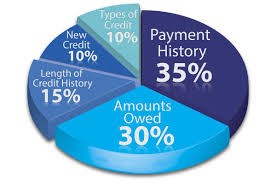“If you don’t take good care of your credit, then your credit won’t take good care of you”…Tyler Gregory
Understanding your credit score can mean the difference between spending thousands of extra dollars in interest and fees or being in a position to save thousands of dollars with prime or better interest rates.
Why do we have credit scores?
While age may be nothing more than a number, your credit score is THE NUMBER used to determine credit worthiness. Your score is a three-digit number that lenders and creditors use to assess their risk in lending you money or extending you credit. Your credit score determines the likelihood that you will repay the money borrowed. When it comes to your credit score there is a lot of information to know and understand.
Up until the 1970’s there was no regulated system to determine who should or shouldn’t receive credit or loans. Receiving credit or loans was largely driven by personal relationships individuals had with bankers. Lending was very much a subjective sport and there was no universal standard to determine credit worthiness. It was the passing of The Fair Credit Reporting Act in 1970 that provided a framework to fairly assess who received a loan. The FCRA allowed for credit determinations to be based on information that could be collected and what kind of information that could be reported instead of individual character. The information that can be collected and shared is sent to the three major credit reporting bureaus: Equifax, Transunion and Experian.
There are numerous types of credit scores circulating today however there are two scoring models that are more widely known than the others and they are your FICO score and Vantage Score. We’re going to briefly explore the origins of each score.
FICO Score
The FICO score is the most popular and widely used model to determine your credit score. FICO which stands for the Fair Isaac Corporation began providing scores in 1989. There are multiple versions of the FICO scoring model and many lenders use different versions. The FICO 8 model is the most commonly used version today although the company introduced an updated FICO 9 model in 2014.
VANTAGE Score
The 2nd most popular scoring model is the Vantage score. The Vantage score was created in 2006 as a collaboration between the three major credit bureaus. The Vantage score is typically the score you will receive when you use popular online sites such as Credit Karma or Credit Sesame®.
Your credit score although just one number is actually a numerical summary of 5 key factors that will influence how high or low your score.
5 Key Factors
➢ Payment History
➢ Total Debt Owed
➢ Age of Credit
➢ Mix or Type of Credit
➢ Inquiries or New Lines of Credit

Not all of these factors are created equally so it’s very important to know not only what each of the 5 factors are but how each of these factors are evaluated. We’re going to explore each of the factors in detail and provide some useful tips on how you can improve or maintain your current score. Although we briefly discussed both the FICO and Vantage score, for the rest of our discussion as it relates to the factors that influence your score, we are going to use the FICO scoring model. While both scoring models use each of the five factors, the weight and influence of each factor varies between the two.
- Payment History (35%) – your payment history accounts for 35% of your credit score which is more than any of the other four factors. Paying your debts consistently on time is crucial to maintaining or improving your score. Nothing will wreck your score faster than failing to pay your bills on time…let me shout that one more time for the folks in the back
NOTHING WILL WRECK YOUR CREDIT FASTER THAN FAILING TO PAY YOUR BILLS ON TIME!!!

The longer you take to pay them and the more often you are late the lower your credit score will fall. Even if you are late by only a few days it could lower your score between 30 – 70 points and could take years bring it back up. Bottom line…pay your bills on time! At Hustle Girl Financial we encourage our clients to pay all debts two days before the due date. Paying it a few days early allows you to correct for any issues that may occur or the creditor doesn’t receive the payment.
💡Tip Time: If you haven’t created a Financial Blueprint and can’t remember when your bills are due, at Hustle Girl Financial we encourage clients to automate their minimum payments. Automating your payment for the minimum due insures you never miss a payment
2. Total Debt Owed (30%) credit utilization or how much of a balance you carry accounts for 30% of your credit score. Debt owed is the second largest factor that influences your score. Credit utilization looks at the combined balances you are carrying across all credit in relation to your total credit limit. The higher your utilization or debt owed the more it will impact your credit score. To improve or maintain your credit score it’s important to keep your use of credit or utilization as low as possible.
CREDIT UTILIZATION CAN BE TRICKY
Understanding credit utilization can be confusing because the score on your credit report reflects the balance on your cards on the last day of your billing cycle. The last day of your billing cycle is often different than your payment due date by a few days. The closing date of your credit card is important because this is the date the creditor uses to calculate interest and finance charges and adds them to your balance. Even if you pay your bills on time each month and pay them in full, your credit utilization can still negatively impact your score depending on the balance you are carrying when the statement closes.
💡Tip Time: If you routinely use most of your available credit each month, the best tip is to pay your statement balance in full. If you can’t pay the balance in full, then pay as much as possible to lower the balance that is reported to the credit bureau.
3. Age of Credit (15%) – the average age of your credit accounts for 15% of your credit The longer you have had credit accounts open, the better as lenders like to see an established history of credit versus a bunch of new accounts that haven’t aged.
💡Tip Time: If you don’t have to cancel an older, unused credit card – DON’T! Cancelling older established credit can actually have a negative impact on your score.
4. Credit Mix (10%) – the type of credit accounts you have on your report accounts for 10% of your overall credit score. Lenders like to see a variety of credit types on your credit report.
💡Tip Time: Creditors like to see more than one type of credit account. If maximizing your score is your goal, then you should have a mixture of revolving (credit cards), installment loans (typical car loan) and open credit. The greater the variety with good payment history, the more favorable your credit score.
5. Inquiries/New Credit (10%) – the number of inquiries and the number of new accounts you open account for 10% of your credit score. Limit the amount of new credit you apply, typically lenders like to see two or fewer applications every six months. Too many credit applications within a short period of time can cause your score to go down – as it looks like your desperate for credit or may be under financial hardship.
💡Tip Time: The one exception to the credit inquiry rule is if the credit inquiries are for the same reason, i.e…shopping for a new car or looking for new car insurance. If the inquiries by the various companies are within the same month typically lenders will only view them as one inquiry.
Remember using credit wisely is critical for a strong financial future. Maintaining a good credit score isn’t difficult but falling into the trap many of us make especially in our 20’s can cause you years of rebuilding your credit. Now that you know the factors that make up your credit score – consistently pay your bills on time, don’t overextend yourself and have a balanced mix of credit. If you struggle with paying your bills on time or frequently overspend – you need to go back to basics and jump start your financial battery.

